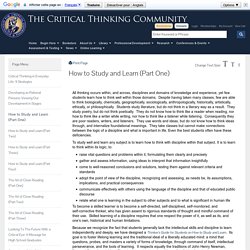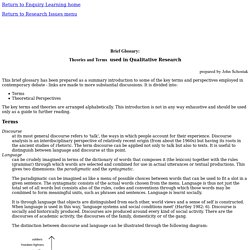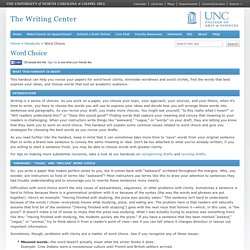

Undertaking a literature review. This guide is the second of three looking at the purpose and process of conducting a literature review. It includes advice on: How to Study and Learn (Part One) All thinking occurs within, and across, disciplines and domains of knowledge and experience, yet few students learn how to think well within those domains.

Despite having taken many classes, few are able to think biologically, chemically, geographically, sociologically, anthropologically, historically, artistically, ethically, or philosophically. Students study literature, but do not think in a literary way as a result. They study poetry, but do not think poetically. Developing your literature review. This guide is the third of three looking at the purpose and process of conducting a literature review. It includes advice on: Printable pdf version: Developing your literature review (this is designed to be printed double-sided on A4 paper, then folded to make an A5 leaflet). "How can I analyse critically and not just be descriptive? " Critical analysis means asking yourself whether you agree with a viewpoint and if so, why? What is it that makes you agree or disagree?
You can ensure you are analysing critically by testing out your own views against those you are reading about: What do you think about the topic? Also think about the methods used to gather the evidence - are they reliable or do they have gaps or weaknesses? Strategies for critical thinking in learning, Part I. Thinking and recall series Strategies for critical thinking in learning and project management Critical thinking studies a topic or problem with open-mindedness.This exercise outlines the first stage of applying a critical thinking approach to developing and understanding a topic.
You will: Develop a statement of the topic List what you understand, what you've been told and what opinions you hold about it Identify resources available for research Define timelines and due datesand how they affect the development of your study Print the list as your reference Here is more on the first stage: Define your destination, what you want to learnClarify or verify with your teacher or an "expert" on your subject Topics can be simple phrases:"The role of gender in video game playing" "Causes of the war before 1939""Mahogany trees in Central America""Plumbing regulations in the suburbs" "Regions of the human brain"
Introduction to Critical Thinking. . :VirtualSalt Robert Harris Version Date: January 1, 2001 What is Critical Thinking? You've been thinking all of your life, of course, for thinking is simply the interaction of ideas. However, thinking is somewhat similar to other skills, like writing, drawing, or fixing cars. How to write a research paper. Planning Ahead Keep track of which assignments are due when, especially those assignments that may require some research materials. Depending on where you live, materials may take a few days or more to reach you.
Last minute requests for library material will be dealt with to the best of our ability, however, planning ahead of time is the best idea. Novanet Express usually takes between 2-4 business days. Interlibrary loan can take weeks depending on the location of the item. How to Write a Reflective Journal. Writing a reflective learning journal. Learning journals. What is a reflective journal? A reflective journal - often called a learning journal - is a steadily growing document that you (the learner) write, to record the progress of your learning. You can keep a learning journal for any course that you undertake, or even for your daily work. This page is mainly about reflective or learning journals for online courses, such as those run by Audience Dialogue. Students from other institutions (including the Open University) are also welcome to use these ideas, though the conditions for marking and submission may be different. A reflective journal is not... simply a summary of the course material.
Who benefits from a reflective journal? You, the learner. There's an old saying "you don't know what you know till you've written it down" - and several research studies have found this to be true. Qualitative Research Design. Qualitative research design is a research method used extensively by scientists and researchers studying human behavior and habits.

It is also very useful for product designers who want to make a product that will sell. For example, a designer generating some ideas for a new product might want to study people’s habits and preferences, to make sure that the product is commercially viable. SurveyMonkey: Free online survey software & questionnaire tool. Glossary for Qualitative Research. Prepared by John Schostak This brief glossary has been prepared as a summary introduction to some of the key terms and perspectives employed in contemporary debate - links are made to more substantial discussions.

It is divided into: Terms Theoretical Perspectives The key terms and theories are arranged alphabetically. This introduction is not in any way exhaustive and should be used only as a guide to further reading. Terms Discourse at its most general discourse refers to 'talk', the ways in which people account for their experience. Language can be crudely imagined in terms of the dictionary of words that composes it (the lexicon) together with the rules (grammar) through which words are selected and combined for use in actual utterances or textual productions. Word Choice. What this handout is about This handout can help you revise your papers for word-level clarity, eliminate wordiness and avoid clichés, find the words that best express your ideas, and choose words that suit an academic audience.

Introduction Writing is a series of choices. As you work on a paper, you choose your topic, your approach, your sources, and your thesis; when it’s time to write, you have to choose the words you will use to express your ideas and decide how you will arrange those words into sentences and paragraphs. As you revise your draft, you make more choices.